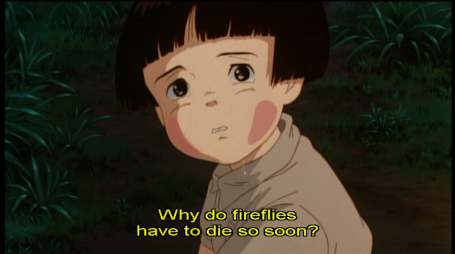By: Guadalupe Mota
This Friday, we were tasked to read Akiyuki Nosaka’s short story “A Grave of Fireflies.” The 15-page story is an autobiographical piece that reflects the life of its author during the 1945 air raid that occurred in his home town of Kobe, Japan. Nosaka, much like the main character Seita, had his entire life shatter in front of him in moments during the raids. Both of his parents died and was left as the sole guardian of his 16-month old sister–unlike the story and film, Setsuko who depicts the role of his sister was 4-years old. This heartbreaking piece begins with the deaths of Seita and Setsuko who died months after the raids. Nosaka’s story tells of their journey of survival but also inevitable deaths. Both the short story and its adapted film interrogate the role of nationalism within the lives of both these children and the livelihoods of Japanese residents. The foreign enemy is never identified in the story, but we are often confronted with the enemy that nationalism plays which further entrenches the suffering of Seita and his sister–with the looming hope that his father, a naval officer, would rescue them.

Screenshot from the movie adaptation of “A Grave of Fireflies”
I highly appreciated the insights of my classmates–especially those who gave honest initial reactions to the short story. Lela pointed out the interesting form Nosaka wrote “A Grave of Fireflies” in. Along with its difficult content, Lela indicated how visibly dense the actual text was. We could go to a page and not find a paragraph break and often read run-on sentences. However, most importantly, she mentioned how entangled the author is within his writing–an important take away that we should all keep in mind when we continue to read fiction stories or watch films rooted in historical specificity. Lela goes on to tell us that the writer should not be rendered invisible–when we analyze these works, we must also understand the personal and historical moments that these creators and artists are bringing into their work. This is particularly true of literature and film-making that present the audience with a traumatic story. The creative process may allow, however, for these difficult stories to be told. As several people mentioned as well, literature can take on the role of telling these stories that history is unable to–where traditional historical methodologies may not be able to tell the emotional truth of a person’s past or of trauma endured by society’s most marginalized.
We also discussed the role that the animated film directed by Isao Takahata had on effectively telling Nosaka’s short story. First, Kenan importantly mentioned the role of music within the movie as it highly contrasted the plotline. He felt that the whimsical and beautiful movie was jarringly placed on top of the tragic lives of Setsuko and Seita. Many other of my classmates agreed that animation allowed the filmmakers to tell the story more accurately than a live-action movie could have. They even agreed with the film critic Roger Ebert when he said that a live-action actress would have taken away from some of the film’s most tragic moments including the death of 4-year old Setsuko. Lela also shared two pages from Understanding Comics by Scott McCloud which supported Ebert’s argument. The first page illustrates the heads of four men. As they appear left to right they become increasingly less detailed, and the comic reads: “When we abstract an image through cartooning we’re not so much eliminating details as we are focusing on specific details. By stripping down the image to its essential “meaning,” an artist can amplify that meaning in a way that realistic art can’t.” Thank you, Lela for providing us with this source.
As for the research project, I am working with my beloved friend, Neva Nowak. Over the weekend, as we drove down Sunset Boulevard, we discussed our mutual love for photography and our intrigue for Japanese films. I mentioned the post-war Japanese photographer Daidō Moriyama whose mostly black and white photographs explore the themes of modernism and nationalism–an academic interest of mine. Neva previously worked on a paper for Professor Uchiyama on the 1971 film Throw Away Your Books, Rally In The Streets–where she explores similar themes. We came to the consensus that we bridge these interests in our final paper where we analyze post-war Japanese films and photography that are themselves critical to modernism and nationalism. As we continue to read and watch sources in this class, we spent about an hour after the lecture discussing our ideas and have begun an outline for our paper.

Black and white photograph by Daidō Moriyama
